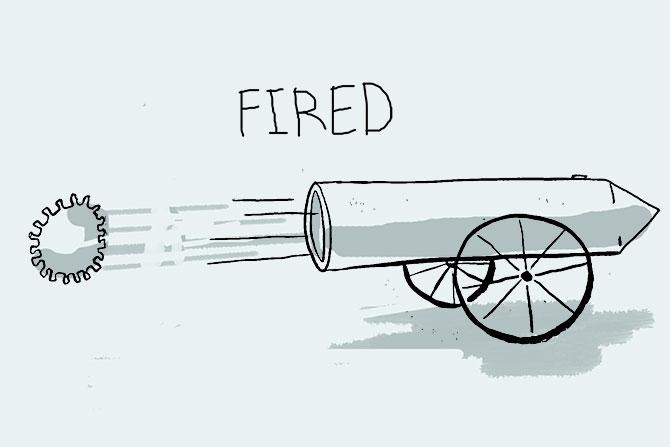 | « Back to article | Print this article |
The cut in wages by companies whose operations were not shut by the lockdown was more likely opportunistic than out of business compulsions to survive the lockdown.
If this is true, then it is worth wondering what kind of opportunism was this?
Was it to make a quick buck or was it to use a crisis to engineer a structural change that was necessary, asks Mahesh Vyas.

Listed companies made their biggest profits during the quarter ended September 2020 in the midst of a lockdown. They did so by cutting costs a lot more sharply than they suffered the fall in sales because of the lockdown.
The cost cutting was essentially in raw material and other operating costs enabled largely by a favourable terms of trade for manufacturing companies.
Total income declined by 6.9 per cent. But costs on raw materials and purchase of finished goods -- the biggest expense head -- declined by a much bigger 18.9 per cent, expenses on salaries grew by 3.4 per cent and other expenses fell by 9 per cent. This helped companies reap their extraordinary profits during the quarter.
Wages account for a relatively small proportion of the total expenses of corporates in India. Its average share before the lockdown was 10 per cent with a range of 7.5-13 per cent in the past 15 years.
As a result, the small 3.4 per cent increase in the wage bill during the September 2020 quarter did not have a significant bearing on the overall growth in profits.
However, what is worth noting and is somewhat intriguing is that firms considered it fit to cut and substantially contain their wage bill although they were making huge profits in the quarter.
A cut in the wage bill could mean a combination of layoffs and wage rate cuts. It is likely that the wage bill was contained largely through a cut in the wage rate for the permanent staff rather than a slashing of headcount of permanent staff.
The axe on headcount is more likely to be through a slashing of contractual labour. Payments made to contractual labour do not show up as wages on the company's financial statements since these payments are made to contractors much like other vendor payments.
Hiring of labour through contractors has been on the rise in recent years. Given this trend, the modest increase in the wage bill may not fully reflect the cut in labour costs of the listed companies under study.
Of the 4,234 companies in the sample, 2,150 companies, or 50 per cent of the companies, cut their wage bill in the September 2020 quarter compared to their levels a year ago.
Another 463 did not show any increase in the wage bill.
And another 339 grew their wage bill by less than 6.92 per cent, which was the inflation rate in the quarter ended September 2020.
Therefore, a total of 2,952 companies, or 70 per cent of all listed companies recorded a fall in wages in real, inflation-adjusted terms.
While on the whole, companies made a lot of profit during the second quarter, many industries suffered severely debilitating loss of business.
Hotels and tourism companies, automobile manufacturers, transport services companies, real estate and mining companies suffered deep losses because of the lockdown.
Given that most of these are also labour-intensive, wage cuts in these industries perhaps, was necessary for survival.
Hotels and tourism companies saw the sharpest year-on-year fall in wages at -37.9 per cent. Transport services companies which include all airlines, road transport services saw its wage bill fall by 32.3 per cent.
Real estate saw an 18.2 per cent fall in its wage bill. None of these declines include the cut in payments made to labour through contractors.
But, these were not the only companies that cut wages.
Of the 2,952 companies that cut real wages, 1,113 companies recorded a more than doubling of their profits during the quarter. 37.7 per cent of the companies doubled their profits but cut wages during the quarter.
Another 117 companies saw their profits grow between 50 and 100 per cent and yet another 224 companies saw their profits grow between 10 and 50 per cent.
Therefore, 1,454 companies or nearly 50 per cent of the companies that cut wages in real terms saw their profits grow by 10 per cent or more.
Save for the industries that were directly and severely impacted by the lockdown, the lockdown did not threaten the profits of companies at large as they reaped the benefits of a fall in commodity prices.
The cut in wages by companies whose operations were not shut by the lockdown therefore, was more likely opportunistic than out of business compulsions to survive the lockdown.
If this is true, then it is perhaps, worth wondering what kind of opportunism was this?
Was it to make a quick buck or was it to use a crisis to engineer a structural change that was necessary?
It is unlikely that businesses would make a quick buck by cutting wages when they could make money elsewhere, such as by cutting other operational costs.
Although India is a labour surplus economy, it is difficult to get and retain good quality labour. It is therefore not wise to short-change them in difficult times. Business leaders understand this.
The cut in wages therefore is more likely to be structural. The crisis of the lockdown is likely to have been used to shed excess labour.
If this is true, then the lost jobs are unlikely to come back or, much of the wage cuts will not be fully restored.
Mahesh Vyas is MD and CEO, CMIE P Ltd.
Feature presentation: Mahipal Soni/Rediff.com.